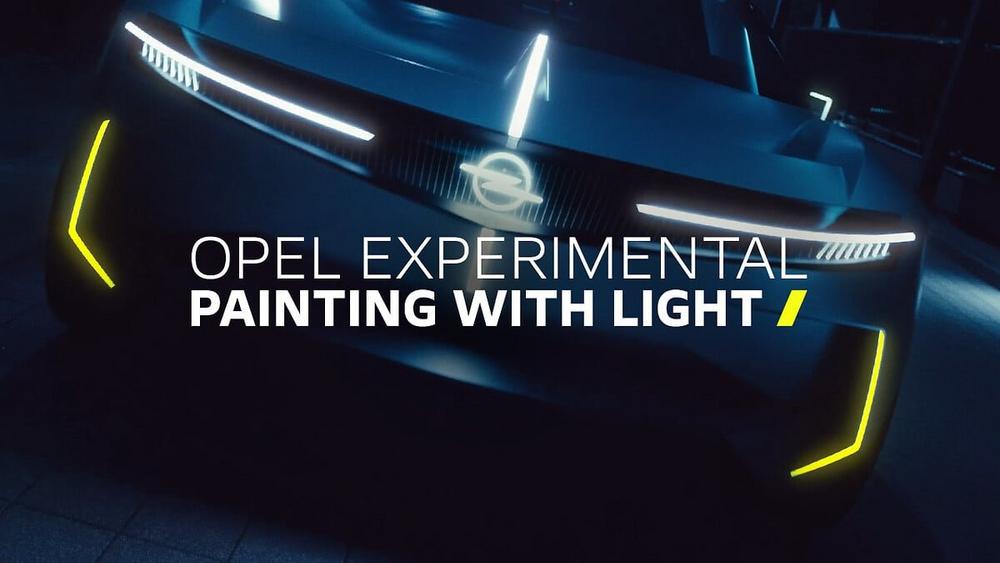
“Painting with Light”: The Opel Experimental Can See in the Dark
- German Energy: Opel Experimental fills brand pillars with new life
- Pioneering: Innovative brand concept shows future of intelligent light
- Deep learning: Artificial intelligence can help cars recognise danger sooner
The visionary Opel Experimental, which CEO Florian Huettl presented to the public for the first time at last year’s IAA Mobility in Munich, gives a glimpse of the brand’s future. This can be characterised in three words:
- Greenovation: The Opel Experimental is fully electric with a reduced carbon footprint.
- Detox: It is bold and pure in design; and focussed on the essentials.
- Modern German: It impresses with its proportions, intelligent aerodynamics, highly efficient use of space and state-of-the-art lighting technology, including for the first time the illuminated Opel Blitz logo.
The Opel Experimental expresses this German Energy in the “Painting with Light” video. It takes viewers on a night-time experiment and shows future lighting technologies. At the same time, it demonstrates that future innovative lighting technology will be capable of much more than simply illuminated the road and the surrounding area. It will increase safety and comfort while also sparking emotions.
Intelli-Lux LED®: Democratisation of lighting technologies has long tradition at Opel
Making pioneering lighting technologies available to customers is a long-standing tradition at Opel. This is demonstrated by the continuous development of IntelliLux LED® Matrix and Pixel Light, which Opel offers for many models, from Corsa to Astra, Mokka and Grandland to the new Combo. Thanks to the adaptive IntelliLux LED® headlights, Opel drivers always have optimum vision in the dark, without dazzling other road users.
“Development is making great strides here,” says Philipp Röckl, Global Lead Complex Lighting at Stellantis. “A few years ago we were able to hide individual ‚blocks of light‘, but the areas that need to be hidden can now be captured more precisely and seamlessly.” This is made possible by, among other things, micro-LED-based HD pixel systems that have an even higher resolution than before and also offer the highest level of energy efficiency. “In addition, we will have to think about light digitally in the future. Today’s standard lighting control modules are no longer sufficient given the high number of pixels. We are already working on vehicle architectures that enable the graphical representation of light,” adds Röckl.
Electrochromic materials and AI: Lighting is more than “just” headlights
The ground-breaking Opel Experimental, a symbol of “German Energy”, shows what this future can look like – inside as well as outside. In the interior, electrochromic materials immerse the passengers in atmospheric light and thus convey a feel-good factor. The reactive materials also have practical properties. For example, if a vehicle, cyclist or pedestrian is in the blind spot of the Opel Experimental, a coloured warning appears on the inside of the respective door as well as in the head-up display. In addition, the external side view recorded by cameras is projected onto the inner door surface. This creates a visual “transparency effect” that allows a view outside to further increase visibility. The new reactive technology can lift the mood and increase the feel-good factor in the cabin while also improving the safety of the driver, passengers and other road users with atmospherically changing light. This is exactly what Opel calls “Painting with Light”.
In the “Painting with Light” video, the Opel Experimental also shows how future lighting technology can expand the view in completely extraordinary ways. Thanks to immersive, digital safety technologies, vehicles like the Opel Experimental can recognise pedestrians quickly – and more clearly than ever before. The augmented reality-based technology then pulsates as a warning signal and displays other important messages and signals for drivers and road users through holograms.
“We want to optimise the light for the driver and also for the camera, so that with the help of AI it can recognize people and animals even better,” explains Röckl. Lighting, camera and sensor technology as well as algorithms must work together for future development so that the car’s predictive and therefore safety-enhancing capabilities can be optimised in every situation.
Opel Pixel Vizor with clear statements: Light as communications tool
Opel has already shown with the award-winning Manta GSe how light signals can arouse emotions and increase safety. Wherever the ultra-modern one-off in retro look appears, it attracts admiring glances. This is due not least to the innovative Opel Pixel Vizor at the front of the Manta GSe. The vehicle can communicate with its surroundings via the Pixel Vizor. Statements like “My German heart has been ELECTRified” or “I am on a zero e‑mission” are written across the front.
The engineers are continuously working on this "light communication of the future" to increase the safety of all road users. The new, atmospheric “Painting with Light” video already gives an indication of how these developments could look like in future.
Opel Automobile GmbH
Bahnhofsplatz 1
65423 Rüsselsheim
Telefon: +49 (6142) 7-70
Telefax: +49 (6142) 77-8409
http://de-media.opel.com/de
Telefon: +49 (6142) 6922084
E-Mail: colin.yong@opel-vauxhall.com
Telefon: +49 (6142) 6927811
E-Mail: carina.elsinger@opel-vauxhall.com
![]()




